1998 GMC SIERRA cv shaft
[x] Cancel search: cv shaftPage 110 of 452
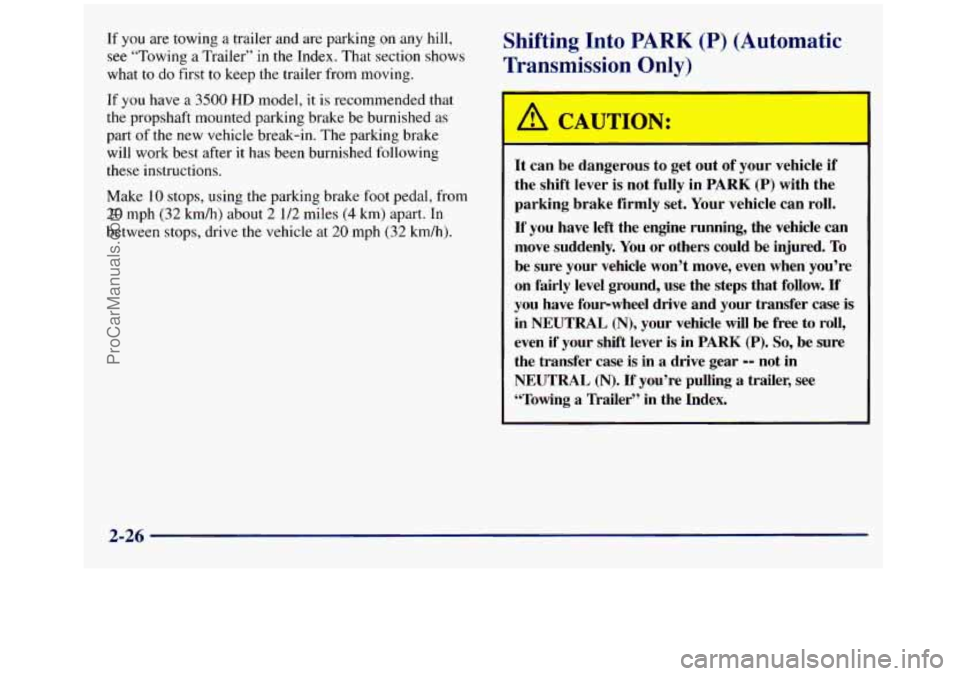
If you are towing a trailer and are parking on any hill,
see “Towing a Trailer” in the Index. That section shows
what to do first
to keep the trailer from moving.
Shifting Into PARK (P) (Automatic
Transmission Only)
If you have a 3500 HD model, it is recommended that
the propshaft mounted parking brake be burnished
as
part of the new vehicle break-in. The parking brake
will work best after
it has been burnished following
these instructions.
Make
10 stops, using the parking brake foot pedal, from
20 mph (32 kmh) about 2 1/2 miles (4 km) apart. In
between stops, drive the vehicle at
20 mph (32 km/h).
A CAUTION:
-
It can be dangerous to get out of your vehicle if
the shift lever is not fully in PARK (P) with the
parking brake firmly
set. Your vehicle can roll.
If you have left the engine running, the vehicle can
move suddenly. You
or others could be injured. To
be sure your vehicle won’t move, even when you’re
on fairly level ground, use the steps that follow.
If
you have fourwheel drive and your transfer case is
in
NEUTRAL (N), your vehicle will be free to roll,
even
if your shift lever is in PARK (P). So, be sure
the transfer case is in a drive gear
-- not in
NEUTRAL (N). If you’re pulling a trailer, see
“Towing a Trailer” in the Index.
2-26
ProCarManuals.com
Page 229 of 452
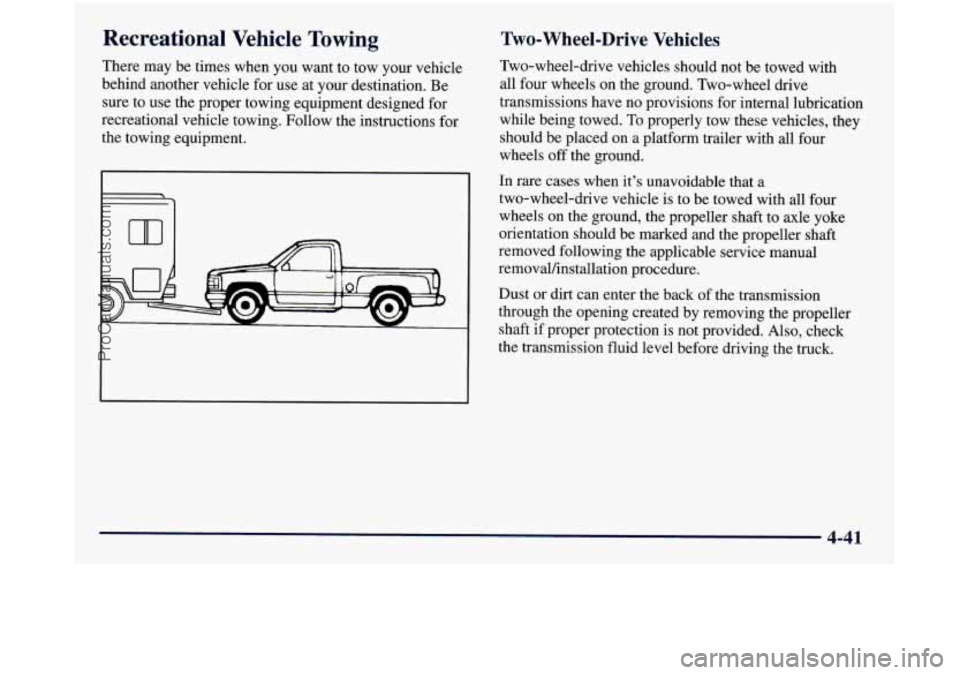
Recreational Vehicle Towing
There may be times when you want to tow your vehicle
behind another vehicle for use at your destination. Be
sure to use the proper towing equipment designed for
recreational vehicle towing. Follow the instructions for
the towing equipment.
I
I1
c
Two-Wheel-Drive Vehicles
Two-wheel-drive vehicles should not be towed with
all four wheels on the ground. Two-wheel drive
transmissions have no provisions for internal lubrication
while being towed. To properly tow these vehicles, they
should be placed on a platform trailer with all four
wheels off the ground.
In
rare cases when it's unavoidable that a
two-wheel-drive vehicle is to be towed with all 'four
wheels on the ground, the propeller shaft to axle yoke
orientation should be marked and the propeller shaft
removed following the applicable service manual
removal/installation procedure.
Dust or dirt can enter the back of the transmission
through the opening created by removing the propeller
shaft if proper protection is not provided. Also, check
the transmission fluid level before driving the truck.
4-41
ProCarManuals.com
Page 278 of 452
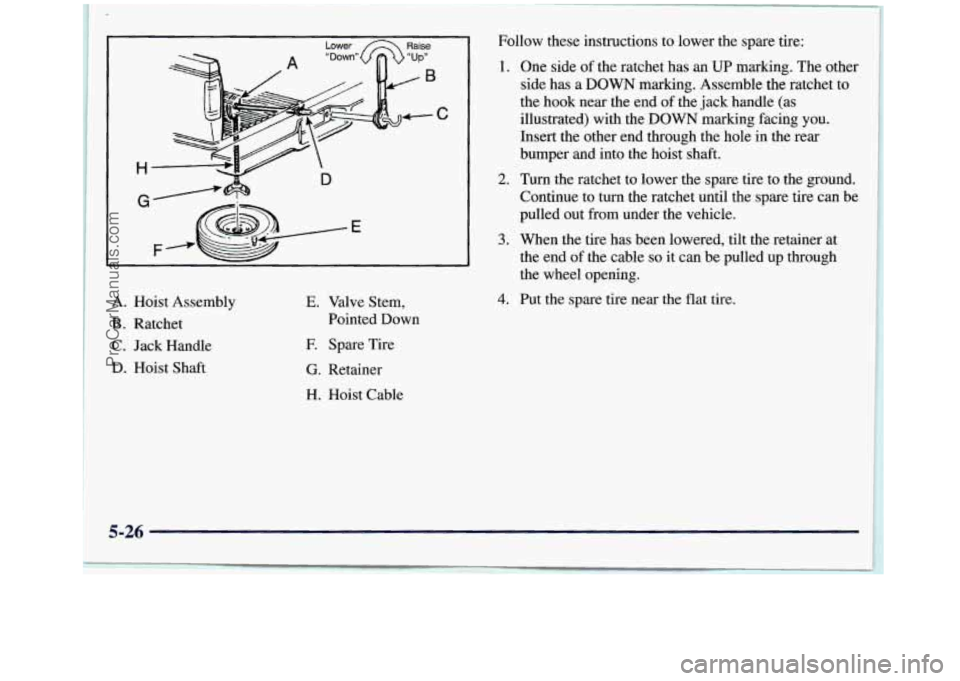
A. Hoist Assembly
€3. Ratchet
C. Jack Handle
D. Hoist Shaft
E. Valve Stem,
Pointed Down
E Spare Tire
G. Retainer
H. Hoist Cable Follow
these instructions to lower the spare tire:
1.
2.
3.
4.
One side of the ratchet has an UP marking. The other
side has
a DOWN marking. Assemble the ratchet to
the hook near the end
of the jack handle (as
illustrated) with the DOWN marking facing you.
Insert the other end through the hole in the rear
bumper and into the hoist shaft.
Turn the ratchet to lower the spare tire to the ground.
Continue to turn the ratchet until the spare tire can be
pulled out from under the vehicle.
When the tire has been lowered, tilt the retainer at
the end
of the cable so it can be pulled up through
the wheel opening.
Put the spare tire near the flat tire.
5-26 I
h
ProCarManuals.com
Page 286 of 452
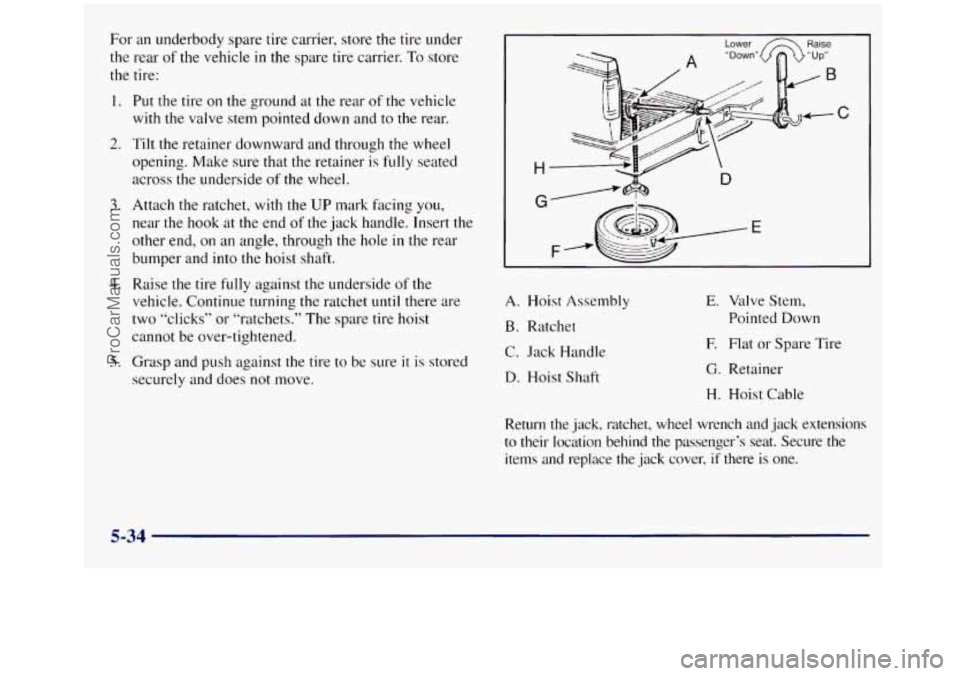
For an underbody spare tire carrier, store the tire under
the rear
of the vehicle in the spare tire carrier. To store
the tire:
1.
2.
3.
4.
5.
Put the tire on the ground at the rear of the vehicle
with the valve stem pointed down and to the rear.
Tilt the retainer downward and through the wheel
opening. Make sure that the retainer
is fully seated
across the underside
of the wheel.
Attach the ratchet, with the
UP mark facing you,
near the hook at the end
of the jack handle. Insert the
other end, on an angle, through
the hole in the rear
bumper and into the hoist shaft.
Raise the tire fully against
the underside of the
vehicle. Continue turning
the ratchet until there. are
two “clicks” or “ratchets.” The spare tire hoist
cannot be over-tightened.
Grasp and push against the tire to be sure
it is stored
securely and does not move.
I Lower Raise
A. Hoist Assembly
B. Ratchet
C. Jack Handle
D. Hoist Shaft
E. Valve Stern,
Pointed Down
E Flat or Spare Tire
G. Retainer
H. Hoist Cable
Return the jack, ratchet, wheel wrench
and jack extensions
to their location behind the passenger’s seat. Secure the
items and replace the jack cover,
if there is one.
5-34
ProCarManuals.com
Page 378 of 452
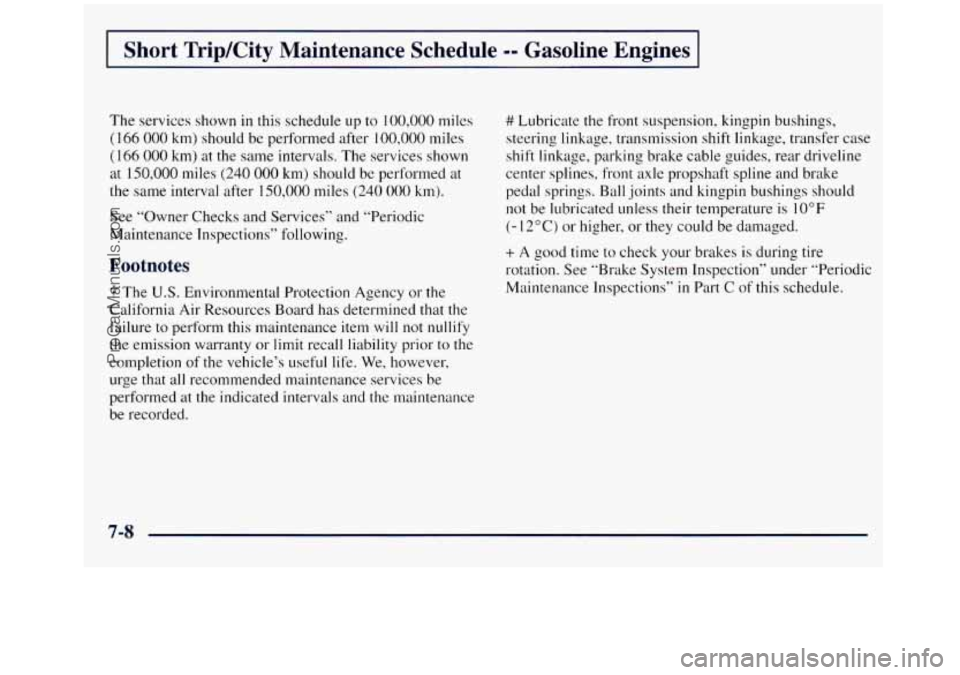
I Short Trip/City Maintenance Schedule -- Gasoline Engines I
The services shown in this schedule up to 100,000 miles
(I 66 000 km) should be performed after 100,000 miles
(166 000 km) at the same intervals. The services shown
at 150,000 miles (240 000 km) should be performed at
the same interval after
150,000 miles (240 000 km).
See “Owner Checks and Services” and ”Periodic
Maintenance Inspections” following.
Footnotes
p The U.S. Environmental Protection Agency or the
California Air Resources Board has determined that the
failure to perform this maintenance item will not
nullify
the emission warranty or limit recall liability prior to the
completion of the vehicle’s useful life. We, however,
urge that all recommended maintenance services be
performed
at the indicated intervals and the maintenance
be recorded.
# Lubricate the front suspension, kingpin bushings,
steering linkage. transmission shift linkage, transfer case
shift linkage, parking brake cable guides, rear driveline
center splines, front axle propshaft spline and brake
pedal springs. Ball joints and kingpin bushings should
not be lubricated unless their temperature is 10°F
(- 12°C) or higher, or they could be damaged.
+ A good time to check your brakes is during tire
rotation. See ”Brake System Inspection’’ under “Periodic
Maintenance Inspections”
in Part C of this schedule.
7-8
ProCarManuals.com
Page 398 of 452
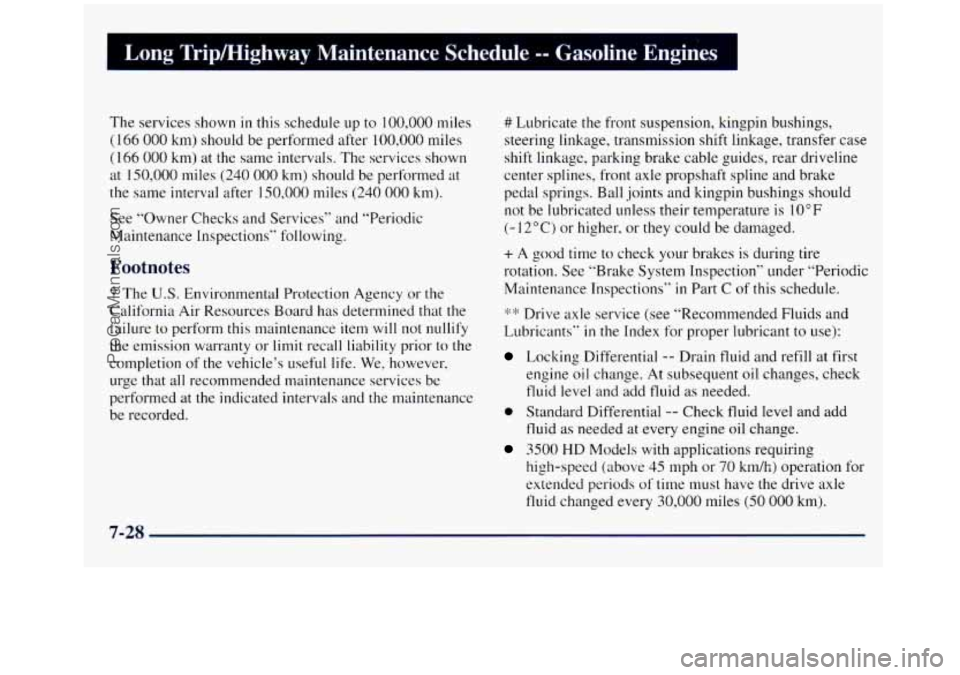
Long TripMighway Maintenance Schedule =- Gasoline Engines
The services shown in this schedule up to 100,000 miles
(166 000 km) should be performed after 100,000 miles
(166 000 km) at the same intervals. The services shown
at 150,000 miles (240 000
km) should be performed at
the same interval after 150,000 miles (240 000 km).
See “Owner Checks and Services” and “Periodic Maintenance Inspections” following.
Footnotes
The U.S. Environmental Protection Agency or the
California Air Resources Board has determined that the
failure
to perform this maintenance item will not nullify
the emission warranty or limit recall liability prior to the
completion of the vehicle’s useful life. We, however,
urge that all recommended maintenance services be
performed at the indicated intervals and the maintenance
be recorded.
# Lubricate the front suspension, kingpin bushings,
steering linkage, transmission
shift linkage, transfer case
shift linkage, parking brake cable guides, rear driveline
center splines, front axle propshaft spline and brake
pedal springs. Ball joints and kingpin bushings should
not be lubricated unless their temperature is 10°F
(- 12°C) or higher, or they could be damaged.
+ A good time to check your brakes is during tire
rotation. See “Brake System Inspection” under “Periodic
Maintenance Inspections”
in Part C of this schedule.
‘+‘K Drive axle service (see “Recommended Fluids and
Lubricants”
in the Index for proper lubricant to use):
Locking Differential -- Drain fluid and refill at first
engine oil change.
At subsequent oil changes, check
fluid level and add fluid as needed.
0 Standard Differential -- Check fluid level and add
fluid
as needed at every engine oil change.
3500 HD Models with applications requiring
high-speed (above 45 mph or 70 kndh) operation
for
extended periods of time must have the drive axle
fluid changed every 30,000 miles
(50 000 km).
7-28
ProCarManuals.com
Page 417 of 452

USAGE
Automatic
Transmission
Key Lock
Cylinders
Linkage
I
Chassis Lubrication
Front Wheel
Bearings
Differential,
Front and Rear
Axle
FLUIDLUBRICANT
DEXRON@-I11 Automatic
Transmission Fluid.
Multi-Pur ose Lubricant,
Superlube
L (GM Part
No. 1234624 1 or equivalent).
Lubriplate@ Lubricant Aerosol
(GM Part No. 12346293 or
equivalent) or lubricant meeting
requirements
of NLGI # 2
Category LB or GC-LB.
Chassis Lubricant (GM Part
No. 12377985 or equivalent) or
lubricant meeting requirements of
NLGI # 2, Category LB or
GC-LB.
Wheel Bearing Lubricant meeting
requirements
of NLGI # 2,
Category GC or GC-LB (GM Part
No. 1 OS 1344 or equivalent).
Axle Lubricant (GM Part
GL-5 Gear Lubricant.
NO. 1052271) or SAE 8OW-90
USAGE
Differential, C3
(HD3500)
Trucks With
Dana Rear Axle
Transfer Case
Windshield
Washer Solvent
Front Axle
Propshaft Spline,
Rear Driveline
Center Splines
and Universal
Joints
One-Piece
Propshaft Spline
(Two-Wheel
Drive with Auto.
Trans
.)
FLUIDLUBRICANT
SAE 75W- 140 Synthetic Gear
Lubricant (GM Part
No. 12346 140) or equivalent.
DEXRON@-111 Automatic
Transmission Fluid.
GM Optikleen@ Washer Solvent
(GM Part
No. 105 15 15)
or equivalent.
Chassis Lubricant (GM Part
No. 12377985 or equivalent) or
lubricant meeting requirements
of
NLGI # 2, Category LE or
GC-LB.
Spline Lubricant, Special
Lubricant (GM Part
No. 12345879) or lubricant
meeting requirements of
GM 998530.
7-47
ProCarManuals.com